Validation of Gross Primary Production Estimated by Remote Sensing for the Ecosystems of Doñana National Park through Improvements in Light Use Efficiency Estimation
Abstract
:1. Introduction
2. Materials and Methods
2.1. Study Site, Instrumentation and Data Sources
2.2. LUE Model
2.2.1. FAPAR Estimation
2.2.2. PAR Estimation
2.2.3. ε Estimation
ε Reduction with Meteorological Variables
ε Reduction with a Water Index
2.3. Evaluation Procedure
3. Results
3.1. Xeric Shrubland
3.2. Marshland
4. Discussion
4.1. GPP Dynamics
4.2. LUE—Models Validation
4.2.1. LUE-Models Validation in Xeric Shrublands
4.2.2. LUE-Models Validation in Marshland
5. Conclusions
Author Contributions
Funding
Data Availability Statement
Acknowledgments
Conflicts of Interest
References
- Green, A.J.; Bustamante, J.; Janss, G.F.E.; Fernández-Zamudio, R.; Díaz-Paniagua, C. Doñana Wetlands. In The Wetland Book: II: Distribution, Description and Conservation; Finlayson, C.M., Milton, G.R., Prentice, R.C., Davidson, N.C., Eds.; Springer: Dordrecht, The Netherlands, 2016; pp. 1–14. (In Spainish) [Google Scholar]
- Morris, E.P.; Flecha, S.; Figuerola, J.; Costas, E.; Navarro, G.; Ruiz, J.; Rodriguez, P.; Huertas, E. Contribution of Doñana Wetlands to Carbon Sequestration. PLoS ONE 2013, 8, e71456. [Google Scholar] [CrossRef] [PubMed]
- Pettorelli, N.; Schulte to Buhne, H.; Tulloch, A.; Dubois, G.; Macinnis-Ng, C.; Queiros, A.M.; Wegmann, M.; Schrodt, F.; Stellmes, F.; Sonnenschein, R.; et al. Satellite remote sensing of ecosystem functions: Opportunities, challenges and way forward. Remote Sens. Ecol. Conserv. 2018, 4, 71–93. [Google Scholar] [CrossRef]
- Arakida, H.; Miyoshi, T.; Ise, T.; Shima, S. Data Assimilation Experiments with Simulated LAI Observations and the Dynamic Global Vegetation Model SEIB-DGVM. In Proceedings of the Japan Geoscience Union Meeting, Chiba, Japan, 24–28 May 2015. [Google Scholar]
- Schimel, D.; Pavlick, R.; Fisher, J.B.; Asner, G.P.; Saatchi, S.; Townsend, P.; Miller, C.; Frankenberg, C.; Hibbard, K.; Cox, P. Observing terrestrial ecosystems and the carbon cycle from space. Glob. Chang. Biol. 2015, 21, 1762–1776. [Google Scholar] [CrossRef] [PubMed]
- Ciais, P.; Reichstein, M.; Viovy, N.; Granier, A.; Ogée, J.; Allard, V.; Aubinet, M.; Buchmann, N.; Bernhofer, C.; Carrara, A.; et al. Europe-Wide Reduction in Primary Productivity Caused by the Heat and Drought in 2003. Nature 2005, 437, 529–533. [Google Scholar] [CrossRef]
- Unger, S.; Máguas, C.; Pereira, J.; Aires, L.; David, T.; Werner, C. Partitioning Carbon Fluxes in a Mediterranean Oak Forest to Disentangle Changes in Ecosystem Sink Strength during Drought. Agric. For. Meteorol. 2009, 149, 949–961. [Google Scholar] [CrossRef]
- Giner, C.; Martínez, B.; Gilabert, M.A.; Alcaraz-Segura, D. Trends in vegetation greenness and gross primary production in Spain (2000–2009)|. Rev. Teledetec. 2012, 38, 51–64. [Google Scholar]
- Sjöström, M.; Zhao, M.; Archibald, S.; Arneth, A.; Cappelaere, B.; Falk, U.; Grandcourt, A.; Hanan, N.; Kergoat, L.; Kutsch, W.; et al. Evaluation of MODIS gross primary productivity for Africa using eddy covariance data. Remote Sens. Environ. 2013, 131, 275–286. [Google Scholar] [CrossRef]
- Huang, X.; Xiao, J.; Wang, X.; Ma, M. Improving the global MODIS GPP model by optimizing parameters with FLUXNET data. Agric. For. Meteorol. 2021, 300, 108314. [Google Scholar] [CrossRef]
- Roxburgh, S.; Berry, S.; Buckley, T.; Barnes, B.; Roderick, M. What Is NPP? Inconsistent Accounting of Respiratory Fluxes in the Definition of Net Primary Production. Funct. Ecol. 2005, 19, 378–382. [Google Scholar] [CrossRef]
- Beer, C.; Reichstein, M.; Tomelleri, E.; Ciais, P.; Jung, M.; Carvalhais, N.; Rödenbeck, C.; Arain, M.A.; Baldocchi, D.; Bonan, G.B.; et al. Terrestrial Gross Carbon Dioxide Uptake: Global Distribution and Covariation with Climate. Science 2010, 329, 834–838. [Google Scholar] [CrossRef]
- Ryu, Y.; Berry, J.A.; Baldocchi, D.D. What is Global Photosynthesis? History, Uncertainties and Opportunities. Remote Sens. Environ. 2019, 223, 95–114. [Google Scholar] [CrossRef]
- Knipper, K.R.; Kustas, W.P.; Anderson, M.C.; Nieto, H.; Alfieri, J.G.; Prueger, J.H.; Hain, C.R.; Gao, F.; McKee, L.G.; Alsina, M.M.; et al. Using high-spatiotemporal thermal satellite ET retrievals to monitor water use over California vineyards of different climate, vine variety and trellis design. Agric. Water Manag. 2020, 241, 106361. [Google Scholar] [CrossRef]
- Celis, J.; Xiao, X.; Basara, J.; Wagle, P.; McCarthy, H. Simple and Innovative Methods to Estimate Gross Primary Production and Transpiration of Crops: A Review. In Digital Ecosystem for Innovation in Agriculture; Chaudhary, S., Biradar, C.M., Divakaran, S., Raval, M.S., Eds.; Studies in Big Data; Springer: Singapore, 2023; Volume 121. [Google Scholar]
- Wellington, M.; Kuhnert, P.; Lawes, R.; Renzullo, L.; Pittock, J.; Ramshaw, P.; Moyo, M.; Kimaro, E.; Tafula, M.; van Rooyen, A. Decoupling crop production from water consumption at some irrigation schemes in southern Africa. Agric. Water Manag. 2023, 284, 108358. [Google Scholar] [CrossRef]
- Cristóbal, J.; Prakash, A.; Anderson, M.C.; Kustas, W.P.; Alfieri, J.G.; Gens, R. Surface Energy Flux Estimation in Two Boreal Settings in Alaska Using a Thermal-Based Remote Sensing Model. Remote Sens. 2020, 12, 4108. [Google Scholar] [CrossRef]
- Gilmanov, T.G.; Verma, S.B.; Sims, P.L.; Meyers, T.P.; Bradford, J.A.; Burba, G.G.; Suyker, A.E. Gross primary production and light response parameters of four Southern Plains ecosystems estimated using long-term CO2-flux tower measurements. Glob. Biogeochem. Cycles 2003, 17, 1071. [Google Scholar] [CrossRef]
- Chu, H.; Luo, X.; Ouyang, Z.; Chan, W.S.; Dengel, S.; Biraud, S.C.; Torn, M.S.; Metzger, S.; Kumar, J.; Arain, M.A.; et al. Representativeness of Eddy-Covariance flux footprints for areas surrounding AmeriFlux sites. Agric. For. Meteorol. 2021, 301–302, 108350. [Google Scholar]
- Hilker, T.; Coops, N.; Wulder, M.; Black, T.; Guy, R. The use of remote sensing in light use efficiency based models of gross primary production: A review of current status and future requirements. Sci. Total Environ. 2008, 404, 411–423. [Google Scholar] [CrossRef] [PubMed]
- Tagesson, T.; Tian, F.; Schurgers, G.; Horion, S.; Scholes, R.; Ahlström, A.; Ardö, J.; Moreno, Á.; Madani, N.; Olin, S.; et al. A Physiology-based Earth Observation Model Indicates Stagnation in the Global Gross Primary Production during Recent Decades. Glob. Chang. Biol. 2020, 27, 836–854. [Google Scholar] [CrossRef] [PubMed]
- Zhu, W.; Xie, Z.; Zhao, C.; Zheng, Z.; Qiao, K.; Peng, D.; Fu, Y.H. Remote sensing of terrestrial gross primary productivity: A review of advances in theoretical foundation, key parameters and methods. Gisci. Remote Sens. 2024, 61, 2318846. [Google Scholar] [CrossRef]
- Pei, Y.; Dong, J.; Zhang, Y.; Yuan, W.; Doughty, R.; Yang, J.; Zhou, D.; Zhang, L.; Xiao, X. Evolution of Light Use Efficiency Models: Improvement, Uncertainties, and Implications. Agric. For. Meteorol. 2022, 317, 108905. [Google Scholar] [CrossRef]
- Ingle, R.; Bhatnagar, S.; Ghosh, B.; Gill, L.; Regan, S.; Connolly, J.; Saunders, M. Development of hybrid models to estimate gross primary productivity at a near-natural Peatland using sentinel 2 data and a light use efficiency model. Remote Sens. 2023, 15, 1673. [Google Scholar] [CrossRef]
- Wang, S.; Garcia, M.; Bauer-Gottwein, P.; Jakobsen, J.; Zarco-Tejada, P.J.; Bandini, F.; Sobejano Paz, V.; Ibrom, A. High spatial resolution monitoring land surface energy, water and CO2 fluxes from an Unmanned Aerial System. Remote Sens. Environ. 2019, 229, 14–31. [Google Scholar] [CrossRef]
- Zhang, Y.; Hu, Z.; Wang, J.; Gao, X.; Yang, C.; Yang, F.; Wu, G. Temporal upscaling of MODIS instantaneous FAPAR improves forest gross primary productivity (GPP) simulation. Int. J. Appl. Earth Obs. Geoinf. 2023, 121, 103360. [Google Scholar] [CrossRef]
- Huertas, I.E.; Flecha, S.; Figuerola, J.; Costas, E.; Morris, E. Effect of Hydroperiod on CO2 Fluxes at the Air-water Interface in the Mediterranean Coastal Wetlands of Doñana. J. Geophys. Res. Biogeosci. 2017, 122, 1615–1631. [Google Scholar] [CrossRef]
- Lumbierres, M.; Méndez, P.F.; Bustamante, J.; Soriguer, R.; Santamaría, L. Modeling biomass production in seasonal wetlands using MODIS NDVI land surface phenology. Remote Sens. 2017, 9, 392. [Google Scholar] [CrossRef]
- Spinosa, A.; Fuentes-Monjaraz, M.A.; El Serafy, G. Assessing the Use of Sentinel-2 Data for Spatio-Temporal Upscaling of Flux Tower Gross Primary Productivity Measurements. Remote Sens. 2023, 15, 562. [Google Scholar] [CrossRef]
- Wei, S.; Yi, C.; Fang, W.; Hendrey, G. A Global Study of GPP Focusing on Light-Use Efficiency in a Random Forest Regression Model. Ecosphere 2017, 8, e01724. [Google Scholar] [CrossRef]
- Monteith, J.L. Solar radiation and productivity in tropical ecosystems. J. Appl. Ecol. 1972, 9, 747–766. [Google Scholar] [CrossRef]
- Monteith, J.L. Climate and the efficiency of crop production in Britain. Philos. Trans. R. Soc. Lond. B Biol. Sci. 1977, 281, 277–294. [Google Scholar]
- Choudhury, B. Estimating Gross Photosynthesis Using Satellite and Ancillary Data: Approach and Preliminary Results. Remote Sens. Environ. 2001, 75, 1–21. [Google Scholar] [CrossRef]
- Fensholt, R.; Sandholt, I.; Rasmussen, M. Evaluation of MODIS LAI, fAPAR and the relation between fAPAR and NDVI in a semi-arid environment using in situ measurements. Remote Sens. Environ. 2004, 91, 490–507. [Google Scholar] [CrossRef]
- Running, S.W.; Thornton, P.E.; Nemani, R.R.; Glassy, J.M. Global terrestrial gross and net primary productivity from the earth observing system. In Methods in Ecosystem Science; Springer: New York, NY, USA, 2000; pp. 44–57. [Google Scholar]
- Du, D.; Zheng, C.; Jia, L.; Chen, Q.; Jiang, M.; Hu, G.; Lu, J. Estimation of global cropland gross primary production from satellite observations by integrating water availability variable in light-use-efficiency model. Remote Sens. 2022, 14, 1722. [Google Scholar] [CrossRef]
- Siljeström, P.A.; Moreno, A.; Garcia, L.V.; Clemente, L.E. Doñana National Park (south-west Spain): Geomorphological characterization through a soil-vegetation study. J. Arid Environ. 1994, 26, 315–323. [Google Scholar] [CrossRef]
- de la Riva, E.G.; Lloret, F.; Pérez-Ramos, I.M.; Marañón, T.; Saura-Mas, S.; Díaz-Delgado, R.; Villar, R. The Importance of Functional Diversity on the Stability of Mediterranean Shrubland Communities after the Impact of Extreme Climatic Events. J. Plant Ecol. 2017, 10, 281–293. [Google Scholar] [CrossRef]
- Pérez-Ramos, I.M.; Díaz-Delgado, R.; de la Riva, E.G.; Villar, R.; Lloret, F.; Marañón, T. Climate Variability and Community Stability in Mediterranean Shrublands: The Role of Functional Diversity and Soil Environment. J. Ecol. 2017, 105, 1335–1346. [Google Scholar] [CrossRef]
- Weiss, M.; Baret, F. S2ToolBox Level 2 Products: LAI, FAPAR, FCOVER, Version 1.1. Available online: http://step.esa.int/docs/extra/ATBD_S2ToolBox_L2B_V1.1.pdf (accessed on 2 May 2016).
- Smets, B.; Cai, Z.; Eklund, L.; Tian, F.; Bonte, K.; Van Hoost, R.; De Roo, B.; Jacobs, T.; Camacho, F.; Sánchez-Zapero, J.; et al. Copernicus Land Monitoring Service High Resolution Vegetation Phenology and Productivity (HR-VPP), Algorithm Theoretical Base Document (ATBD); European Environment Agency: Copenhagen, Denmark, 2024. [Google Scholar]
- Szeicz, G. Solar Radiation for Plant Growth. J. Appl. Ecol. 1974, 11, 617–636. [Google Scholar] [CrossRef]
- Muñoz Sabater, J. ERA5-Land hourly datafrom 1981 to present. Copernicus Climate Change Service (C3S) Climate Data Store (CDS). Available online: https://doi.org/10.24381/cds.e2161bac (accessed on 15 October 2023).
- Gorelick, N.; Hancher, M.; Dixon, M.; Ilyushchenko, S.; Thau, D.; Moore, R. Google Earth Engine: Planetary-scale geospatial analysis for everyone. Remote Sens. Environ. 2017, 202, 18–27. [Google Scholar] [CrossRef]
- Running, S.W.; Nemani, R.R.; Heinsch, F.A.; Zhao, M.; Reeves, M.; Hashimoto, H. A continuous satellite-derived measure of global terrestrial primary production. Bioscience 2004, 54, 547. [Google Scholar] [CrossRef]
- Elfarkh, J.; Johansen, K.; El Hajj, M.M.; Almashharawi, S.K.; McCabe, M.F. Evapotranspiration, gross primary productivity and water use efficiency over a high-density olive orchard using ground and satellite based data. Agric. Water Manag. 2023, 287, 108423. [Google Scholar] [CrossRef]
- Garbulsky, M.F.; Peñuelas, J.; Papale, D.; Ardö, J.; Goulden, M.L.; Kiely, G.; Richardson, A.D.; Rotenberg, E.; Veenendaal, E.M.; Filella, I. Patterns and controls of the variability of radiation use efficiency and primary productivity across terrestrial ecosystems. Glob. Ecol. Biogeogr. 2010, 19, 253–267. [Google Scholar] [CrossRef]
- Gómez-Giráldez, P.J.; Aguilar, C.; Caño, A.B.; GarcíaMoreno, A.; González-Dugo, M.P. Remote sensing estimation of net primary production as monitoring indicator of holm oak savanna management. Ecol. Indic. 2019, 106, 105526. [Google Scholar] [CrossRef]
- Padilla, F.L.M.; Maas, S.J.; González-Dugo, M.P.; Mansilla, F.; Rajan, N.; Gavilán, P.; Domínguez, J. Monitoring regional wheat yield in Southern Spain using the GRAMI model and satellite imagery. Field Crop. Res. 2012, 130, 145–154. [Google Scholar] [CrossRef]
- Running, S.W.; Zhao, M. User’s Guide Daily GPP and Annual NPP (MOD17A2H/A3H) and Year-end GapFilled (MOD17A2HGF/A3HGF) Products NASA Earth Observing System MODIS Land Algorithm (For Collection 6). 2021. Available online: https://modis-land.gsfc.nasa.gov/pdf/MOD17C61UsersGuideV11Mar112021.pdf (accessed on 11 March 2021).
- Gao, B.-C. NDWI—A normalized difference water index for remote sensing of vegetation liquid water from space. Remote Sens. Environ. 1996, 58, 257–266. [Google Scholar] [CrossRef]
- Mohammadi, A.; Costelloe, J.F.; Ryu, D. Application of time series of remotely sensed normalized difference water, vegetation and moisture indices in characterizing flood dynamics of large-scale arid zone floodplains. Remote Sens. Environ. 2017, 190, 70–82. [Google Scholar] [CrossRef]
- Xiao, X.; Braswell, B.; Zhang, Q.; Boles, S.; Frolking, S.; Moore, B. Sensitivity of vegetation indices to atmospheric aerosols: Continental-scale observations in Northern Asia. Remote Sens. Environ. 2003, 84, 3. [Google Scholar] [CrossRef]
- Wilczak, J.M.; Oncley, S.P.; Stage, S.A. Sonic anemometer tilt correction algorithms. Bound.—Layer Meteorol. 2001, 99, 127–150. [Google Scholar] [CrossRef]
- Vickers, D.; Mahrt, L. Quality control and flux sampling problems for tower and aircraft data. J. Atmos. Ocean. Technol. 1997, 14, 512–526. [Google Scholar] [CrossRef]
- Lasslop, G.; Reichstein, M.; Papale, D.; Richardson, A.; Arneth, A.; Barr, A.; Stoy, P.; Wohlfahrt, G. Separation of net ecosystem exchange into assimilation and respiration using a light response curve approach: Critical issues and global evaluation. Glob. Chang. Biol. 2010, 16, 187–208. [Google Scholar] [CrossRef]
- Wutzler, T.; Lucas-Moffat, A.; Migliavacca, M.; Knauer, J.; Sickel, K.; Šigut, L.; Menzer, O.; Reichstein, M. Basic and extensible post-processing of eddy covariance flux data with REddyProc. Biogeosciences 2018, 15, 5015–5030. [Google Scholar] [CrossRef]
- Papale, D.; Reichstein, M.; Aubinet, M.; Canfora, E.; Bernhofer, C.; Kutsch, W.; Longdoz, B.; Rambal, S.; Valentini, R.; Vesala, T.; et al. Towards a standardized processing of net ecosystem exchange measured with eddy covariance technique: Algorithms and uncertainty estimation. Biogeosciences 2006, 3, 571–583. [Google Scholar] [CrossRef]
- Barr, A.G.; Richardson, A.D.; Hollinger, D.Y.; Papale, D.; Arain, M.A.; Black, T.A.; Bohrer, G.; Dragoni, D.; Fischer, M.L.; Gu, L.; et al. Use of change-point detection for friction–velocity threshold evaluation in eddy-covariance studies. Agric. For. Meteorol. 2013, 171, 31–45. [Google Scholar] [CrossRef]
- Falge, E.; Baldocchi, D.; Olson, R.; Anthoni, P.; Aubinet, M.; Bernhofer, C.; Burba, G.; Ceulemans, R.; Clement, R.; Dolman, H.; et al. Gap filling strategies for long term energy flux data sets. Agric. For. Meteorol. 2001, 107, 71–77. [Google Scholar] [CrossRef]
- Reichstein, M.; Falge, E.; Baldocchi, D. On the separation of net ecosystem exchange into assimilation and ecosystem respiration: Review and improved algorithm. Glob. Chang. Biol. 2005, 11, 1424–1439. [Google Scholar] [CrossRef]
- Hsieh, C.I.; Katul, G.; Chi, T.W. An approximate analytical model for footprint estimation of scalar fluxes in thermally stratified atmospheric flows. Adv. Water Resour. 2000, 23, 765–772. [Google Scholar] [CrossRef]
- Detto, M.; Montaldo, N.; Albertson, J.D.; Mancini, M.; Katul, G. Soil moisture and vegetation controls on evapotranspiration in a heterogeneous Mediterranean ecosystem on Sardinia, Italy. Water Resour. Res. 2006, 42, 8. [Google Scholar] [CrossRef]
- Serrano, L.; Esquivias-Segura, M.P.; Zunzunegui, M. Long-term hydrological changes over a seventeen-year period in temporary ponds of the Doñana NP (SW Spain). Limnetica 2008, 27, 065–078. [Google Scholar] [CrossRef]
- ICTS-RBD, ICTS de la Reserva Biológica de Doñana. Programa de Seguimiento de Procesos y Recursos Naturales. Espacio Natural de Doñana. Memoria 2018; CSIC—Estación Biológica de Doñana (EBD): Sevilla, Spain, 2019; Available online: https://digital.csic.es/handle/10261/279075 (accessed on 18 April 2023).
- Frank, D.; Reichstein, M.; Miglietta, F.; Pereira, J.S. Impact of climate variability and extremes on the carbon cycle of the Mediterranean region. In Regional Assessment of Climate Change in the Mediterranean: Volume 2: Agriculture, Forests and Ecosystem Services and People; Springer: Dordrecht, The Netherlands, 2013; pp. 31–47. [Google Scholar]
- Cueva, A.; Bullock, S.H.; Méndez-Alonzo, R.; López-Reyes, E.; Vargas, R. Foliage Senescence as a Key Parameter for Modeling Gross Primary Productivity in a Mediterranean Shrubland. J. Geophys. Res. Biogeosci. 2021, 126, e2020JG00583. [Google Scholar] [CrossRef]
- Jia, X.; Mu, Y.; Zha, T.; Wang, B.; Qin, S.; Tian, Y. Seasonal and interannual variations in ecosystem respiration in relation to temperature, moisture, and productivity in a temperate semi-arid shrubland. Sci. Total Environ. 2020, 709, 136210. [Google Scholar] [CrossRef] [PubMed]
- Rich, P.M.; Breshears, D.D.; White, A.B. Phenology of mixed woody–herbaceous ecosystems following extreme events: Net and differential responses. Ecology 2008, 89, 342–352. [Google Scholar] [CrossRef] [PubMed]
- Shunlin, L.; Xiaowen, L.; Jindi, W. Vegetation production in terrestrial ecosystems. In Advanced Remote Sensing; Meat & Livestock; Australia Limited ABN: Sydney, Australia, 2012; pp. 501–531. [Google Scholar]
- Chen, B.; Black, T.A.; Coops, N.C.; Hilker, T.; Trofymow, J.A.; Morgenstern, K. Assessing tower flux footprint climatology and scaling between remotely sensed and eddy covariance measurements. Bound.—Layer Meteorol. 2009, 130, 137–167. [Google Scholar] [CrossRef]
- Gómez-Giráldez, P.J.; Cristóbal, J.; Nieto, H.; Díaz-Delgado, R. Estimation of surface energy and CO2 fluxes through remote sensing in a Juniper tree ecosystem at the National Park of Doñana. In Sixth Recent Advanced in Quantitative Remote Sensing; RAQRS: Valencia, Spain, 2022; pp. 34–39. [Google Scholar]
- Gilabert, M.A.; Moreno, A.; Maselli, F.; Martínez, B.; Chiesi, M.; Sánchez-Ruiz, S.; García-Haro, F.J.; Pérez-Hoyos, A.; Campos-Taberner, M.; Pérez-Priego, O.; et al. Daily GPP estimates in Mediterranean ecosystems by combining remote sensing and meteorological data. ISPRS J. Photogramm. 2015, 102, 184–197. [Google Scholar] [CrossRef]
- Migliavacca, M.; Meroni, M.; Busetto, L.; Colombo, R.; Zenone, T.; Matteucci, G.; Manca, G.; Seufert, G. Modeling Gross Primary Production of Agro-Forestry Ecosystems by Assimilation of Satellite-Derived Information in a Process-Based Model. Sensors 2009, 9, 922–942. [Google Scholar] [CrossRef] [PubMed]
- Ding, L.; Li, Z.; Xu, K.; Huang, M.; Shen, B.; Hou, L.; Xiao, L.; Liang, S.; Shi, Z.; Wang, X.; et al. A water stress factor based on normalized difference water index substantially improved the accuracy of light use efficiency model for arid and semi-arid grasslands. J. Environ. Manag. 2024, 349, 119566. [Google Scholar] [CrossRef] [PubMed]
- Zhang, Z.; Zhou, Y.; Ju, W.; Chen, J.; Xiao, J. Accumulated soil moisture deficit better indicates the effect of soil water stress on light use efficiency of grasslands during drought years. Agric. For. Meteorol. 2023, 329, 109276. [Google Scholar] [CrossRef]
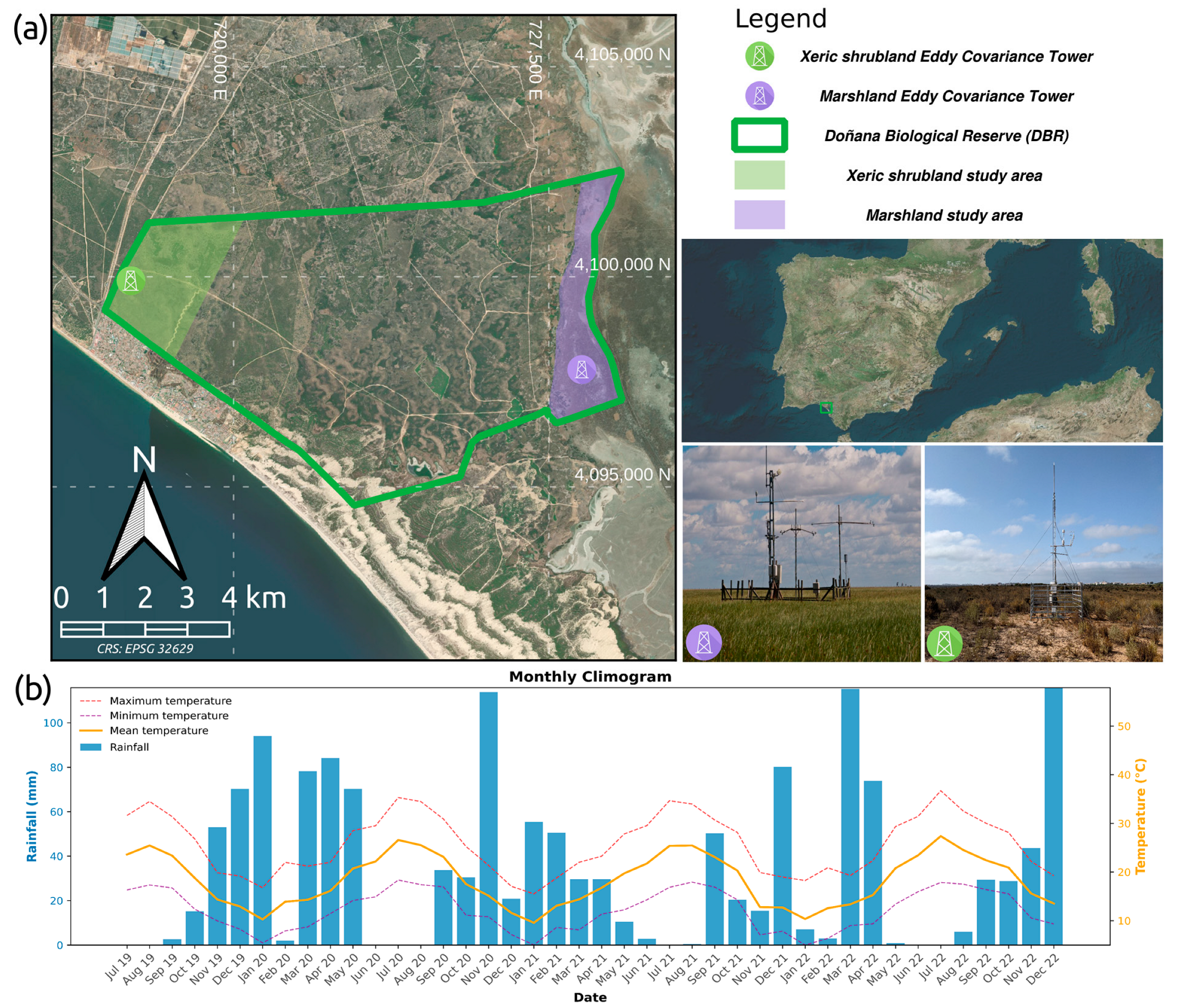
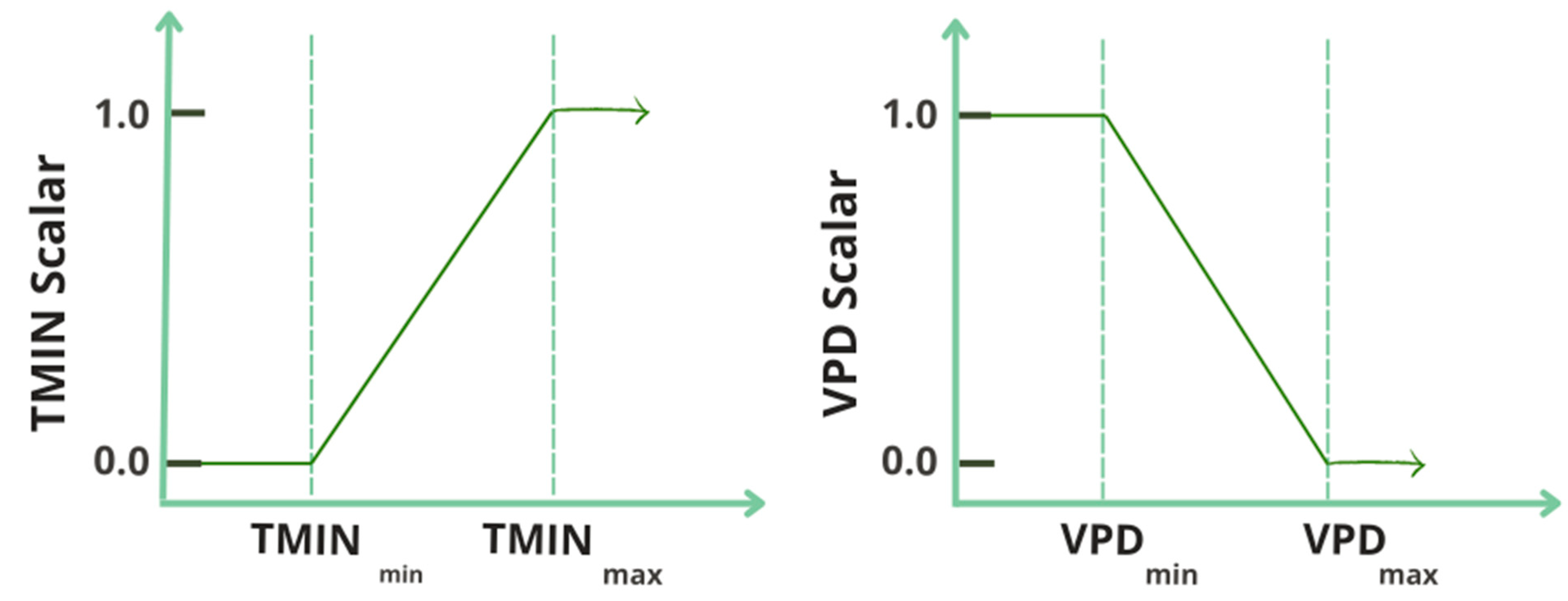
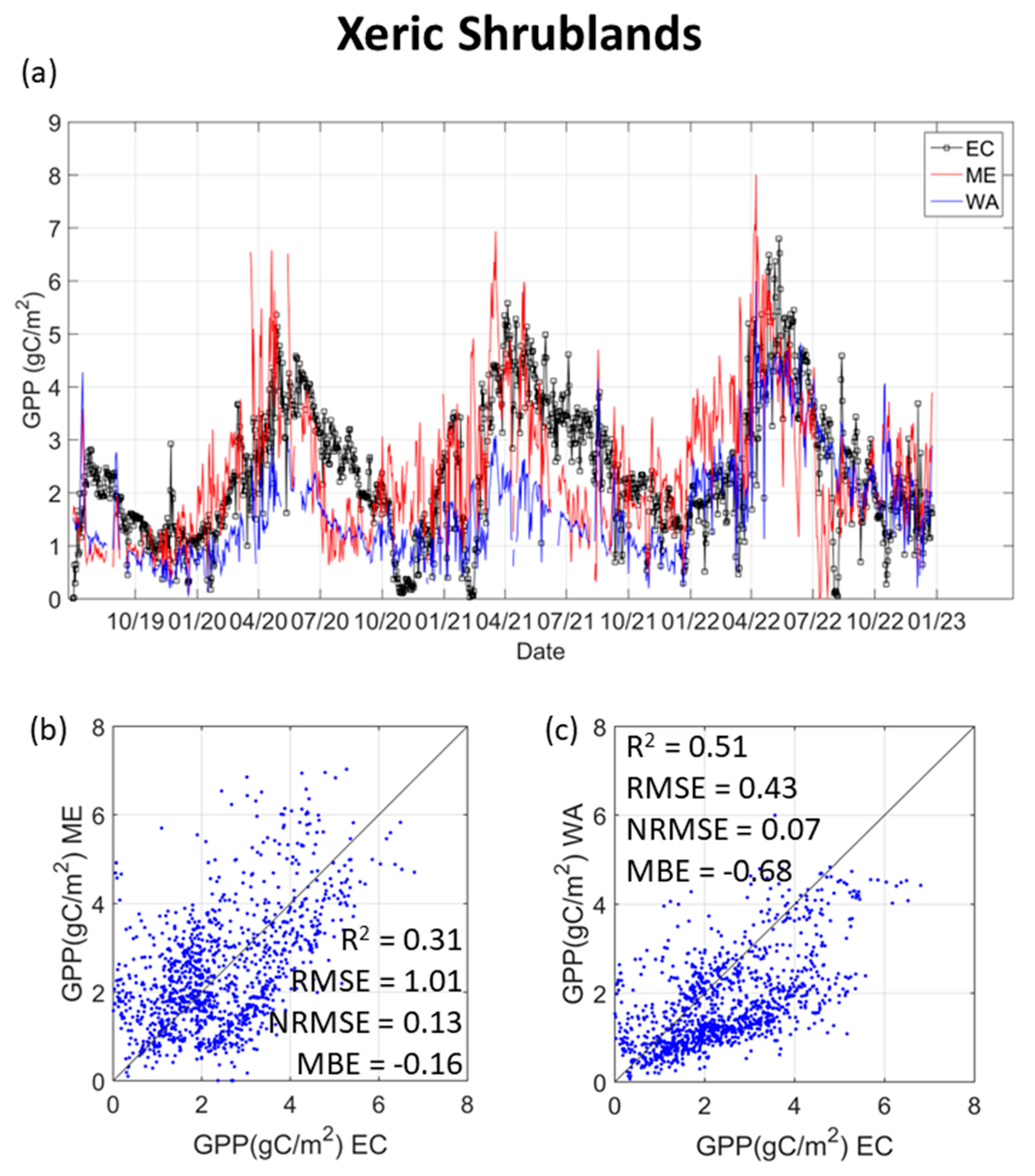
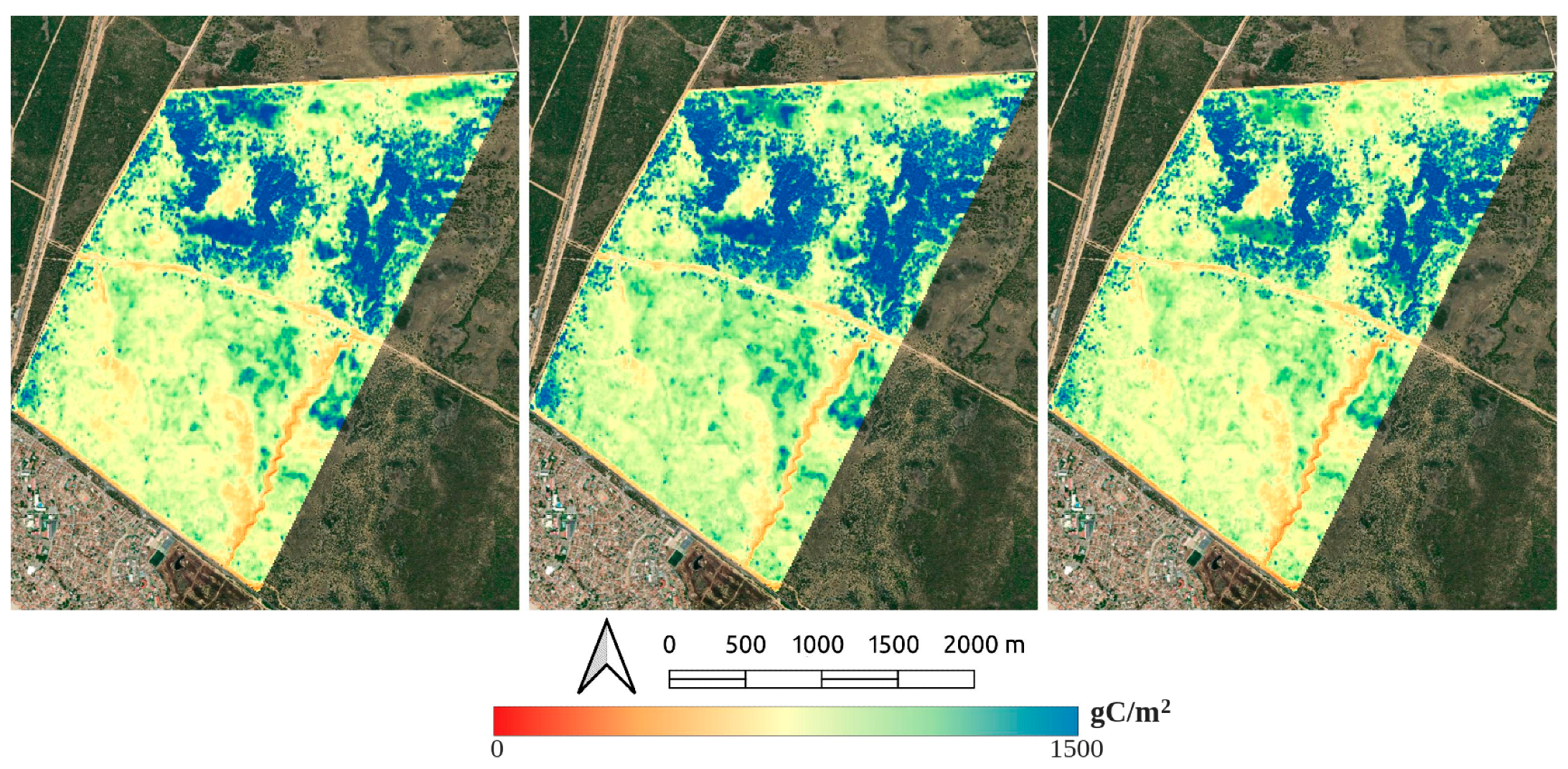
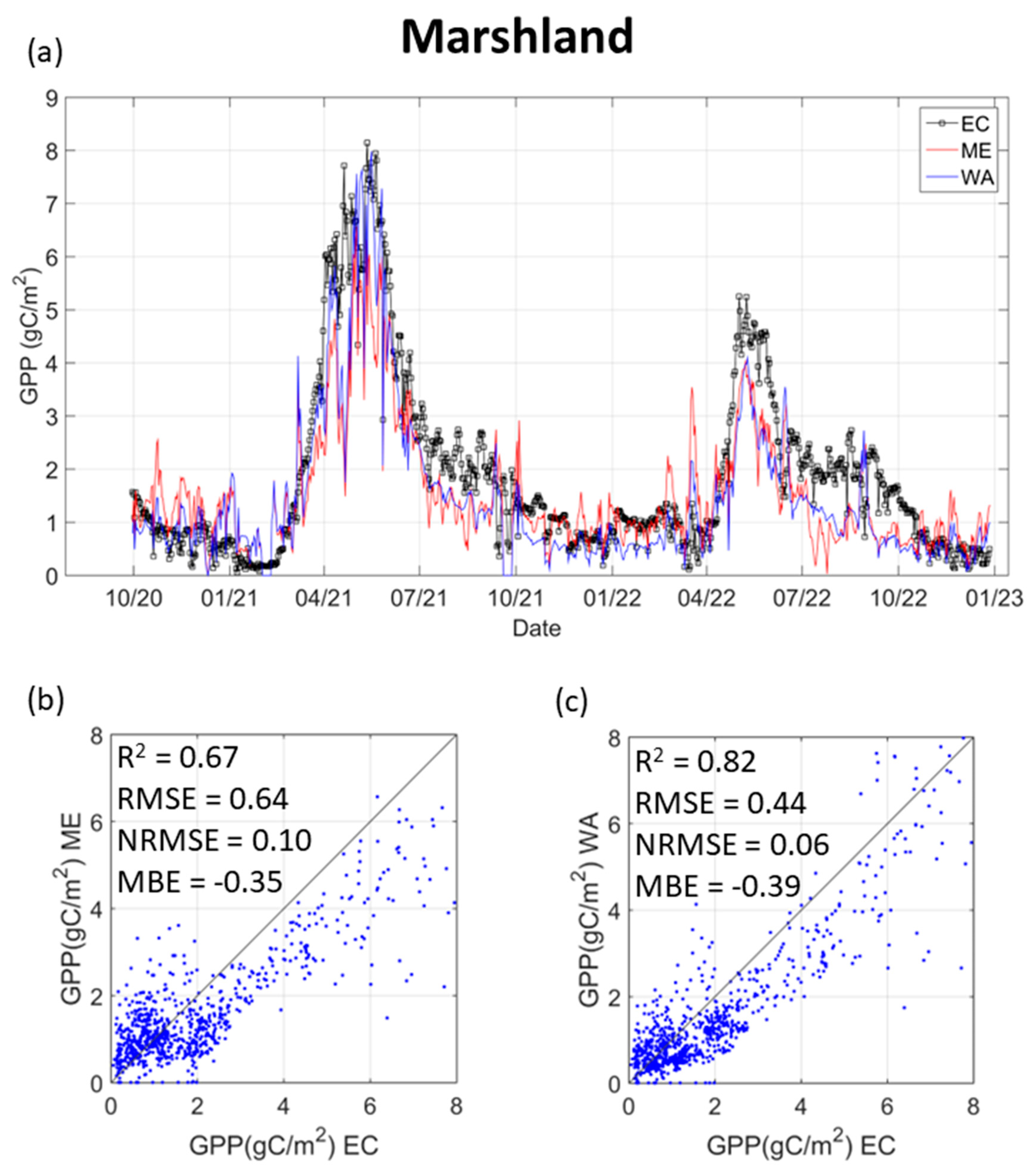

| Ecosystem | Sensor | Variable | Frequency |
|---|---|---|---|
| Xeric shrubland | CNR4 Kipp & Zonnen 1 | Incoming shortwave radiation | 5 min |
| LI-7500 DS 2 | Carbon and water storage | 10 Hz | |
| WindMaster 3D 3 | Sonic temperature, three-dimensional wind speed and direction | 10 Hz | |
| HMP155A 4 | Air temperature and relative humidity | 5 min | |
| Marshland | CNR4 Kipp & Zonnen 1 | Incoming shortwave radiation | 5 min |
| LI-7500 DS 2 | Carbon and water storage | 10 Hz | |
| Gill HS-50 3 | Sonic temperature, three-dimensional wind speed and direction | 10 Hz | |
| WXT520 4 | Air temperature and relative humidity | 5 min |
| Dataset | Variable | Source | Spatial Resolution (m) | Number of Images |
|---|---|---|---|---|
| Sentinel-2 | FAPAR | Copernicus High Resolution Vegetation Phenology and Productivity | 10 | 257 |
| Bands 8 and 12 | Google Earth Engine | 10 | 150 | |
| ERA5-Land | surface_solar_radiation_downwards_sum, temperature_2m_min, temperature_2m, dewpoint_temperature_2m | ECMWF | 11,132 | 1278 |
| LUE Model | Metric | Value |
|---|---|---|
| ME | R2 | 0.36 |
| RMSE | 0.73 | |
| NRMSE | 0.19 | |
| MBE | −0.19 | |
| WA | R2 | 0.74 |
| RMSE | 0.21 | |
| NRMSE | 0.06 | |
| MBE | −0.55 |
| LUE Model | Metric | Value |
|---|---|---|
| ME | R2 | 0.86 |
| RMSE | 0.40 | |
| NRMSE | 0.09 | |
| MBE | −0.35 | |
| WA | R2 | 0.93 |
| RMSE | 0.40 | |
| NRMSE | 0.06 | |
| MBE | −0.41 |
Disclaimer/Publisher’s Note: The statements, opinions and data contained in all publications are solely those of the individual author(s) and contributor(s) and not of MDPI and/or the editor(s). MDPI and/or the editor(s) disclaim responsibility for any injury to people or property resulting from any ideas, methods, instructions or products referred to in the content. |
© 2024 by the authors. Licensee MDPI, Basel, Switzerland. This article is an open access article distributed under the terms and conditions of the Creative Commons Attribution (CC BY) license (https://creativecommons.org/licenses/by/4.0/).
Share and Cite
Gómez-Giráldez, P.J.; Cristóbal, J.; Nieto, H.; García-Díaz, D.; Díaz-Delgado, R. Validation of Gross Primary Production Estimated by Remote Sensing for the Ecosystems of Doñana National Park through Improvements in Light Use Efficiency Estimation. Remote Sens. 2024, 16, 2170. https://doi.org/10.3390/rs16122170
Gómez-Giráldez PJ, Cristóbal J, Nieto H, García-Díaz D, Díaz-Delgado R. Validation of Gross Primary Production Estimated by Remote Sensing for the Ecosystems of Doñana National Park through Improvements in Light Use Efficiency Estimation. Remote Sensing. 2024; 16(12):2170. https://doi.org/10.3390/rs16122170
Chicago/Turabian StyleGómez-Giráldez, Pedro J., Jordi Cristóbal, Héctor Nieto, Diego García-Díaz, and Ricardo Díaz-Delgado. 2024. "Validation of Gross Primary Production Estimated by Remote Sensing for the Ecosystems of Doñana National Park through Improvements in Light Use Efficiency Estimation" Remote Sensing 16, no. 12: 2170. https://doi.org/10.3390/rs16122170





